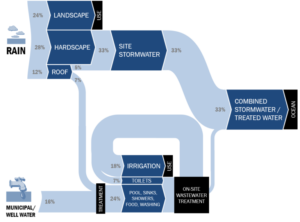Practical Application
Menu
Practical Application
- Identify the most appropriate person to undertake the water audit. Consider whether it is appropriate to engage a professional auditor certified by the Irrigation Association™ (see Resources: Irrigation Association).
- Create log sheets to record total water used by each facility and grounds. Use monthly utility bills, ideally comparing two to three years of data, to establish typical water use patterns.
- Identify all water sources and major end uses, and complete diagrams of site water systems and quantities (Figure 5).
- Determine which end uses are metered or submetered and record which end uses should be targeted for meter installations. This determination should be based on highest consumption, such as irrigation or cooling tower water use.
- Record subtotal water use at each meter on a monthly basis.
- Identify unmetered uses and estimate water consumption.
- Determine whether there are leaks or losses based on unexpected spikes in utility or metered end uses.
- Calculate water consumption per full-time equivalent (FTE) occupants and compare regionally between similar building types to identify anomalies and prioritize conservation efforts. Divide measured water consumption by the number of FTE. This should be identified for each building if individual building metering has been implemented.
- Document findings in an audit report that captures existing water uses, metered sources, data sources, assumptions, and recommendations. Categorize opportunities for water reduction as no-, low-, or high-cost initiatives, as well as short-, mid-, or long-term initiatives.
Figure 5: Water balance diagram identifies water sources and end uses


